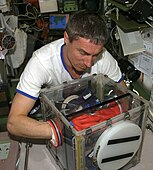Glovebox
This article needs additional citations for verification. (April 2011) |
| Other names | Isolator |
|---|---|
| Uses | Inert atmosphere work Hazardous materials work |
| Related items | Desiccator Schlenk line |
A glovebox (or glove box) is a sealed container that is designed to allow one to manipulate objects where a separate atmosphere is desired. Built into the sides of the glovebox are gloves arranged in such a way that the user can place their hands into the gloves and perform tasks inside the box without breaking containment. Part or all of the box is usually transparent to allow the user to see what is being manipulated. Two types of gloveboxes exist. The first allows a person to work with hazardous substances, such as radioactive materials or infectious disease agents, and the second allows manipulation of substances that must be contained within a very high purity inert atmosphere, such as argon or nitrogen. It is also possible to use a glovebox for manipulation of items in a vacuum chamber.

Inert atmosphere work
The gas in a glovebox is pumped through a series of treatment devices which remove
An alternative to using a glovebox for air sensitive work is to employ Schlenk methods using a
Inert atmosphere gloveboxes are typically kept at a higher pressure than the surrounding air, so that any microscopic leaks are mostly leaking inert gas out of the box instead of letting air in.
Hazardous materials work
At the now-deactivated
. Manipulation of the lead-lined gloves was onerous work.Some gloveboxes for radioactive work are under inert conditions, for instance, one nitrogen-filled box contains an argon-filled box. The argon box is fitted with a gas treatment system to keep the gas very pure to enable electrochemical experiments in molten salts.[1]
Gloveboxes are also used in the biological sciences when dealing with anaerobes or high-biosafety level pathogens.
Gloveboxes used for hazardous materials are generally maintained at a lower pressure than the surrounding atmosphere, so that microscopic leaks result in air intake rather than hazard outflow. Gloveboxes used for hazardous materials generally incorporate HEPA filters into the exhaust, to keep the hazard contained.
Gallery
-
Metal glovebox for handling dangerous substances in vacuum, with extra protection against explosions or implosions
-
Sergei Krikalev working with a portable glovebox at the International Space Station
-
Multiple-port glovebox allowing access by several operators from different sides
-
A glovebox-like shield built around an experimental setup
-
Large scale glovebox in the nuclear industry
-
A scientist in UCL Chemical Engineering uses a glovebox to manipulate a sample
-
An ordinary glovebox, showing the two gloves for manipulation, with airlock on the right
-
Glovebox with microscope and airlock
-
Nano Material handling glove box
-
Inert glovebox using for pharmaceutical application (hygroscopic samples weighing and packing)
-
Supercapacitor test cell assembly in an argon dry chamber. Modern supercapacitors work with an organic electrolyte that must be protected from moisture. Therefore, the supercapacitor was filled with electrolyte in a dry chamber in high purity argon environment
See also
- Desiccators are used for storing chemicals which are moisture-sensitive, but do not react quickly or violently with water.
- Fume hoods are used for hazardous material handling where less operator protection and the same atmosphere can be used.
- Hot cells often use remote manipulators to provide radiological containment where more operator protection is required.
- Sandblasting cabinetsare a type of glovebox which shield the user from the high-velocity abrasive particles inside.
- Schlenk lines are used for manipulating oxygen- and moisture-sensitive chemicals.
References
- ^ Institute for Transuranium Elements Archived 2012-02-05 at the Wayback Machine. jrc.ec.europa.eu
External links
- Rob Toreki (24 May 2004). "Glove Boxes". Custom Packaging. Interactive Learning Paradigms Incorporated.
- Tomme (24 May 2004). "Glove Boxes". The Glassware Gallery. Interactive Learning Paradigms Incorporated.
- American Glovebox Society
- Hans-Jürgen Bässler und Frank Lehmann: Containment Technology: Progress in the Pharmaceutical and Food Processing Industry. Springer, Berlin 2013











